Rough Puff Pastry (Easy Foolproof Recipe)
Deliciously laminated dough without the fuss? That’s what this quick & easy recipe for Rough Puff Pastry promises. Using 4 ingredients and just 1 hour of time, you can have a buttery, flaky, and delicious dupe for the traditional French dough that’s used to make everything from croissants and turnovers to sweet tarts and pot pies!
About Rough Puff Pastry
After receiving lots of requests for a puff pastry recipe, I decided to give it a go. I tried making traditional puff pastry in the conventional French manner, but a.) the recipe always took several hours, and b.) something would almost always go wrong.
Since I love to share easy, foolproof recipes with my readers, I settled on this simplified “rough puff” pastry method. If you follow along with my step-by-step instructions, you’ll get a gorgeously flaky dough every time!
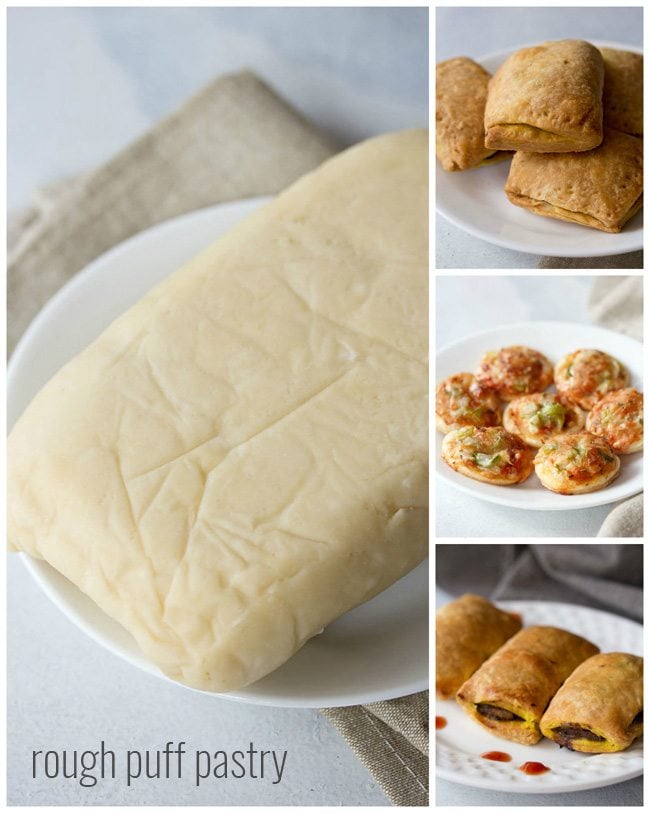
Adapted from The Baker’s Manual book, this recipe results in perfect puffs with a crisp, flaky texture. Though rough puff pastry doesn’t rise quite as much as regular puff pastry, I can assure you the results are definitely close enough for even the most dedicated home baker.
The recipe is super simple and you just need to get the techniques right. In one hour, your rough puff pastry will be ready. Start with just 4 to 5 minutes mixing in the initial round, and then spend 10 to 12 minutes when you reach the rolling step.
Between these two major steps, all you do need to refrigerate the rolled pastry sheet for about 45 minutes. Easy, right?
Use this simple, foolproof method to make a puff pastry dough that will make your Veg Puff, Pizza Puff, and Mushroom Puff out of this world!
Ingredient Notes
You don’t need much to make a gorgeously laminated rough puff pastry. Here’s everything you should gather:
- All-Purpose Flour (Maida) – Don’t try to swap in whole wheat flour here in an attempt to be healthy; the texture will not come out correctly. If possible, reach for organic flour or unbleached flour for the best quality results.
- Unsalted Butter – If you only have salted butter on hand, simply skip adding the salt to the recipe.
- Salt – I use sea salt or pink salt for my everyday cooking, but if you are working with kosher salt, table salt, or any other type of salt, you can refer to a salt conversion chart to ensure proper measurement.
- Ice Cold Water – As with making Pie Dough, you need your ingredients to be very cold. Make sure you use water that has been chilled down with plenty of ice to keep your butter from melting.
How To Make Rough Puff Pastry
Cut Butter Into Flour
1. Take 3 cups all purpose flour and 1 teaspoon salt in a large bowl/pan or on your work surface.
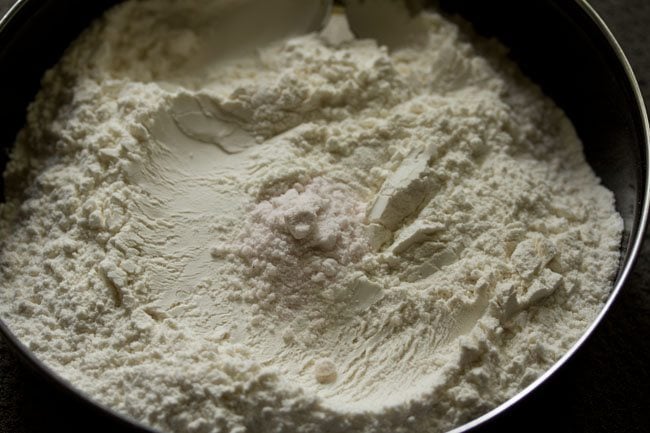
2. Mix very well and keep aside. If you want, you can sift flour and salt together.
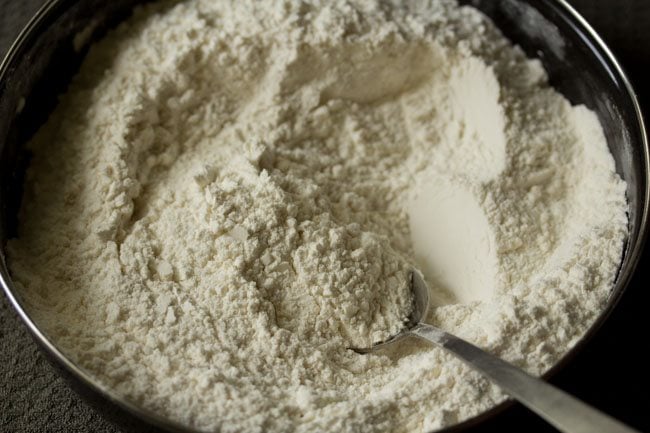
3. Take 250 grams cold unsalted butter and chop it in 1 inch cubes. Overall you will need 2 cups chopped butter. Do note the butter has to be cold and hard. It should not be soft.
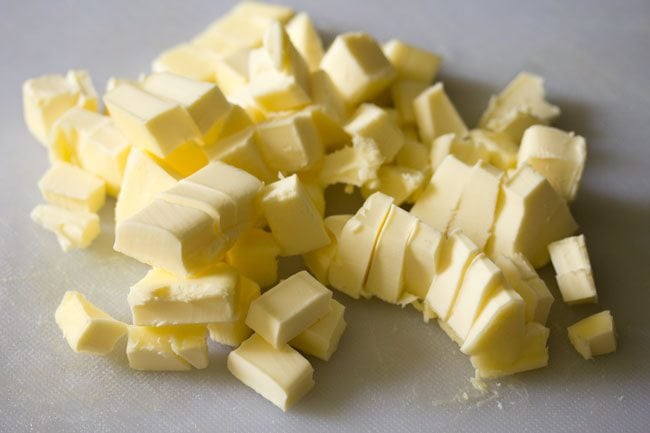
4. Now add the cold butter cubes to the flour and salt mixture.
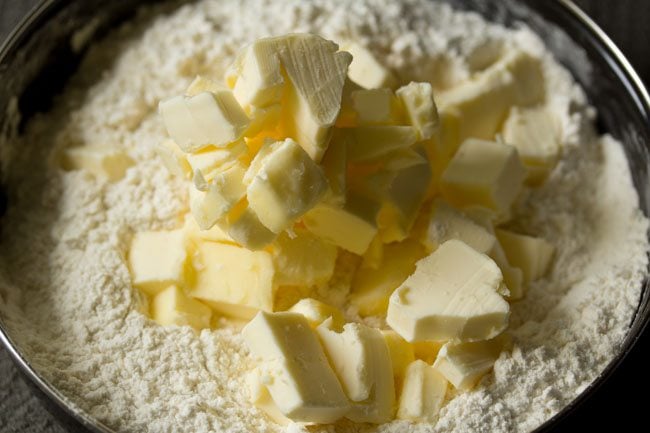
5. With a knife or pastry cutter, roughly cut the butter in the flour.
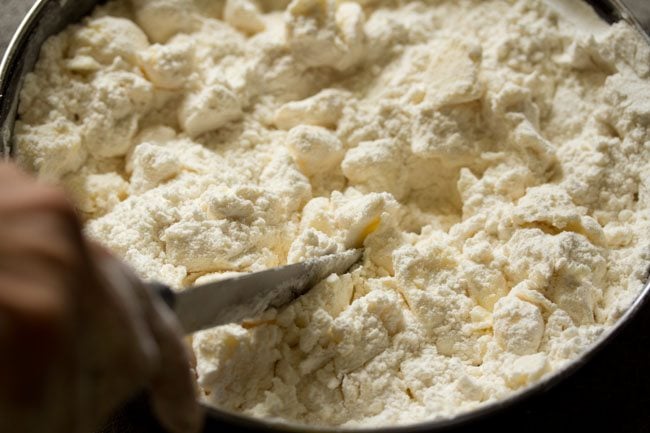
6. Some large pieces or cubes of butter should be there. Do not make to a breadcrumb consistency.
The butter should not melt. If the butter begins to melt, then cover with lid and place in the refrigerator for 30 minutes.
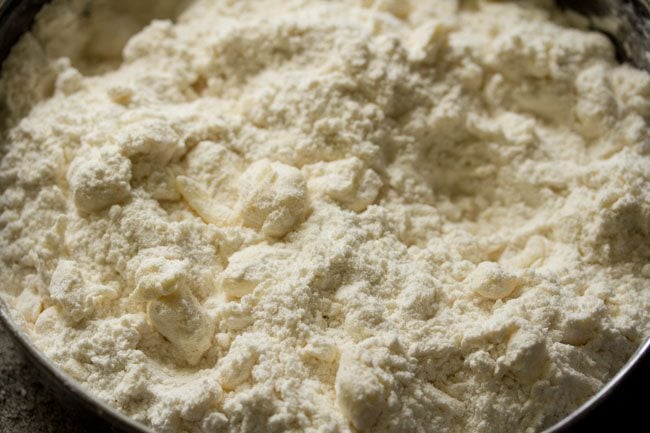
Make Puff Pastry Dough
7. Then sprinkle ¼ cup + 1 tablespoon ice cold water all over. The water also has to be very cold. So do chill water in the freezer before preparing the pastry.
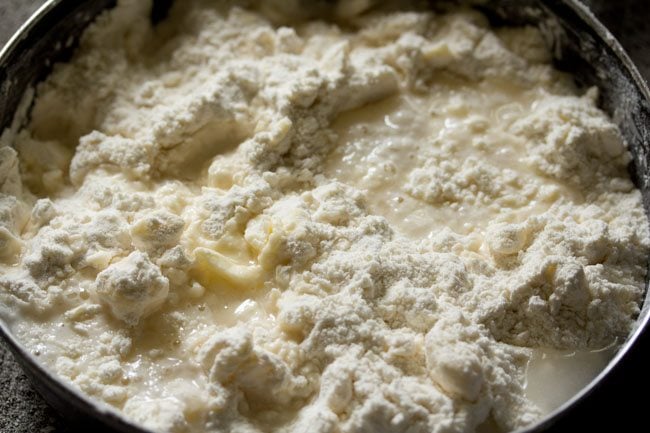
8. Mix with your hands and gently bring the dough together. Add 1 or 2 tablespoons more water if required to bind the dough or if the mixture looks very dry. Do not knead.
You just need to collect and gather the dough. There will be some pieces of butter in the flour and its fine.
In case the dough becomes moist or sticky, then add a few tablespoons of flour.
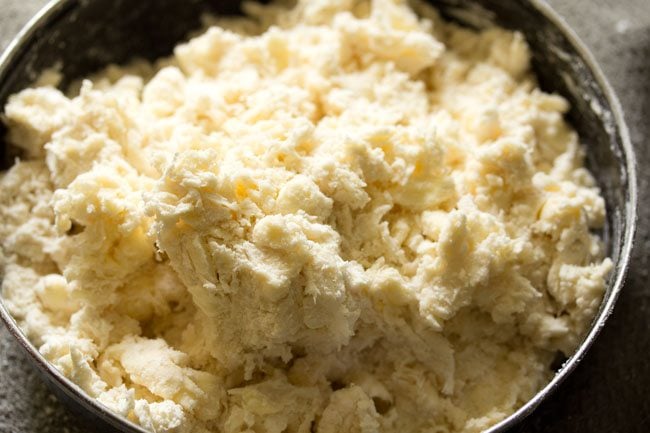
9. When you get a rough piece of dough together, then cover with a lid and place in the same bowl or another bowl. Refrigerate for 45 minutes to an hour.
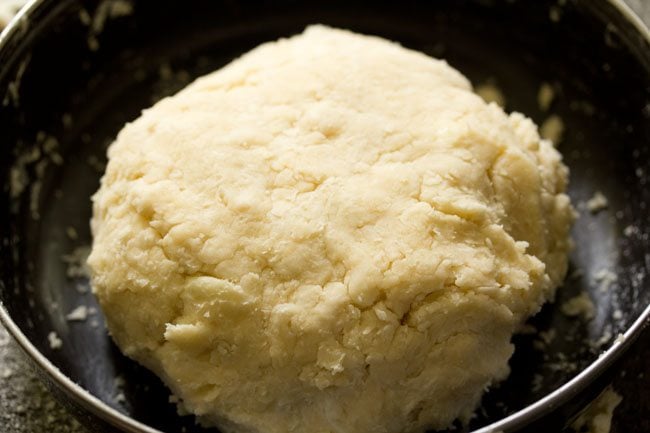
10. After 45 minutes, sprinkle some flour on your work surface.
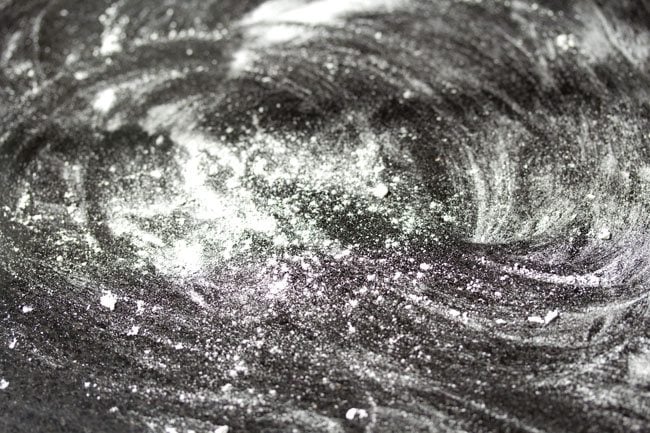
Fold and Roll Pastry Dough
11. Later remove the rough dough from the fridge and place it on the sprinkled work surface.
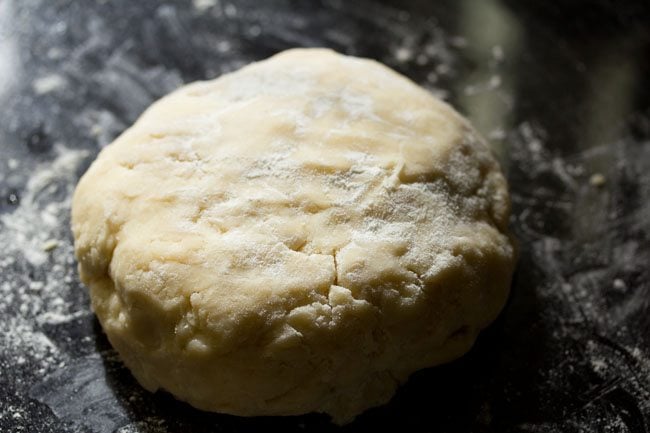
12. Sprinkle some flour on the dough also. Now gently roll the dough with a rolling pin, in one stroke downward.
If any piece of dough comes out, then stick it back to the dough.
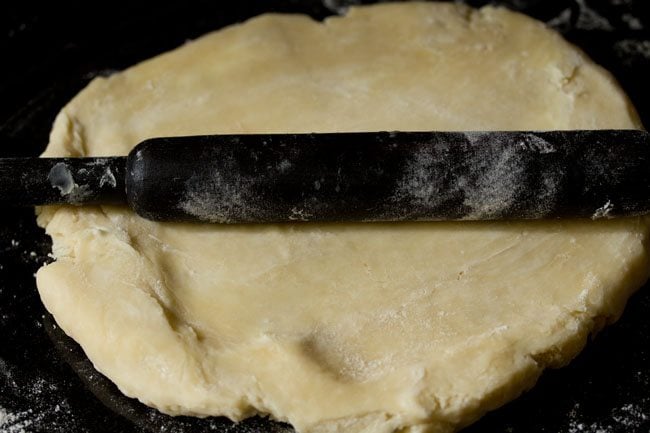
13. Make a 20 inches by 8 cm rectangle shape. With the rolling pin, even the edges to get a rectangle like shape.
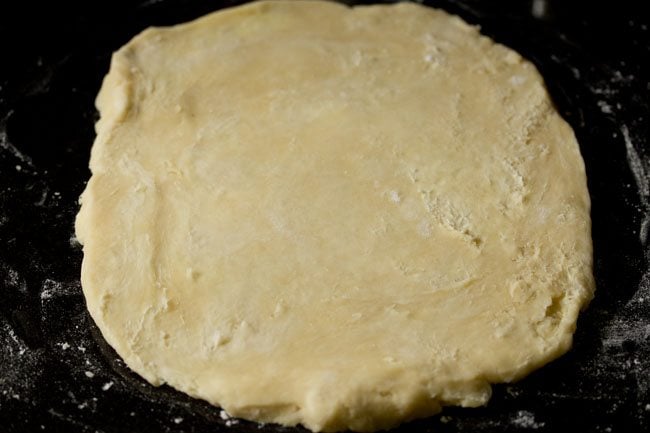
14. Now make two fold. First fold from top and bring the fold till center of the rolled dough.
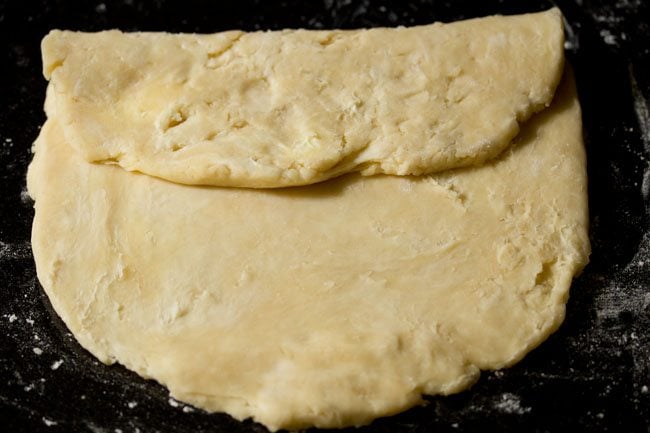
15. Overlap the second fold on top of the first fold. If you see, the pastry dough looks jagged and not even.
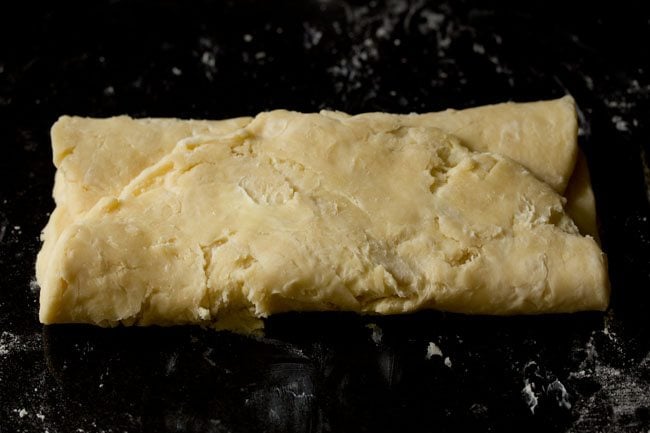
16. Now lift the folded dough and place the overlapped folded side facing your left hand side. The dough will be facing lengthwise to you.
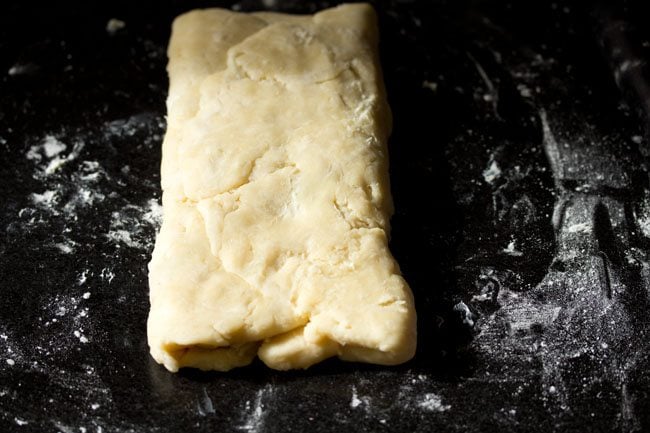
17. Again sprinkle some flour and gently roll in one stroke to make a rectangle.
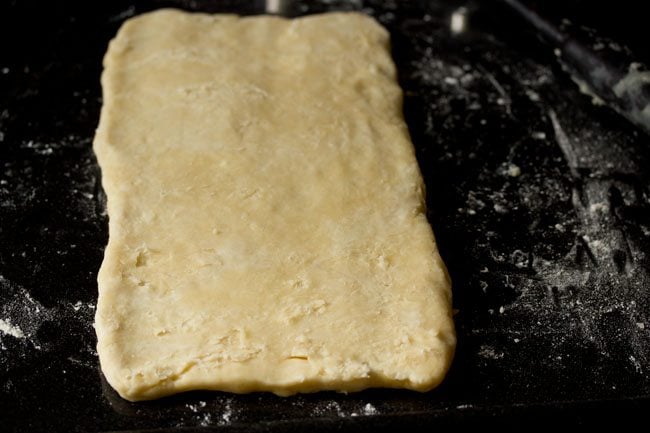
18. Again fold like it was done earlier. Here the photo is with the fold downwards.
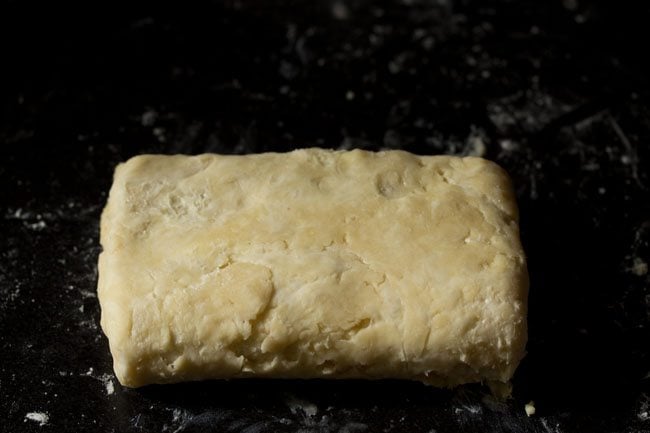
19. Again keep the overlapped folded side facing your left hand side and gently roll. Sprinkle some flour if required.
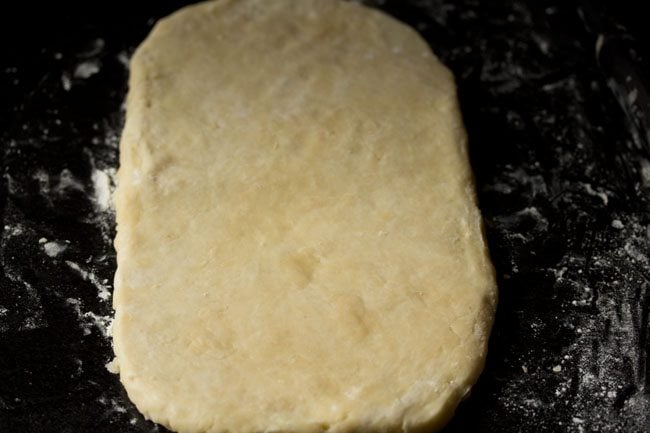
20. Fold again in the same way.
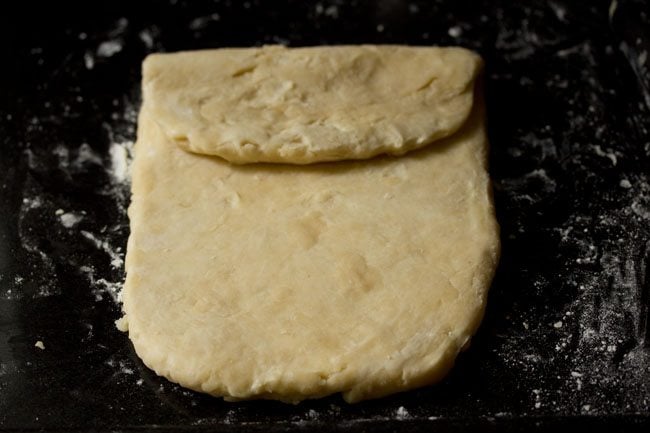
21. Here is a photo of the folded dough. This is the third time I was folding. Just to show you the dough texture.
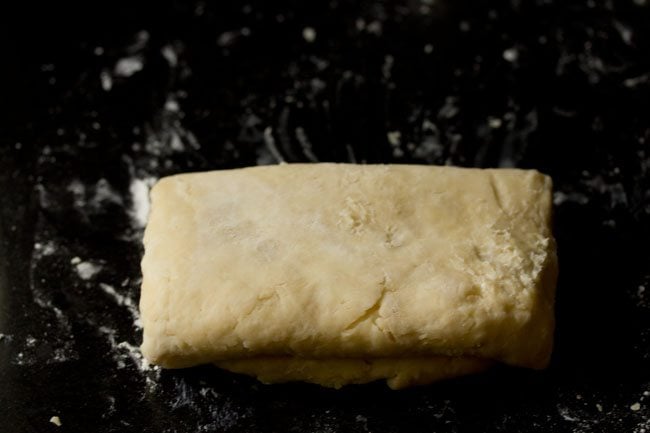
22. Lift and change the position. Sprinkle flour and roll again.
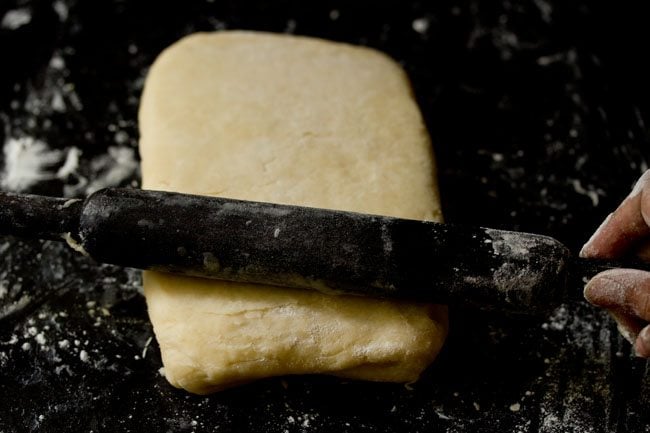
23. Here is the folded dough the fourth time. You will see the dough has become much more smoother.
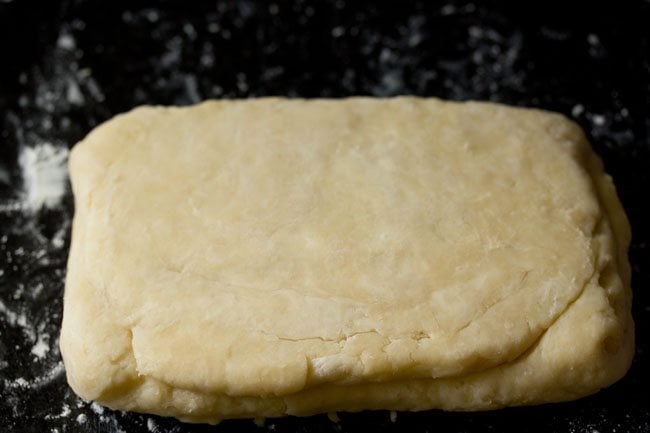
24. Again roll and then fold. I did this rolling and folding for 6 times. So the rolling and folding has to be done for 6 to 7 times.
If the butter begins to melt, then refrigerate the dough for 20 minutes after every fold. Cover the dough and keep in the fridge. In hot and warm temperatures you may need to do this.
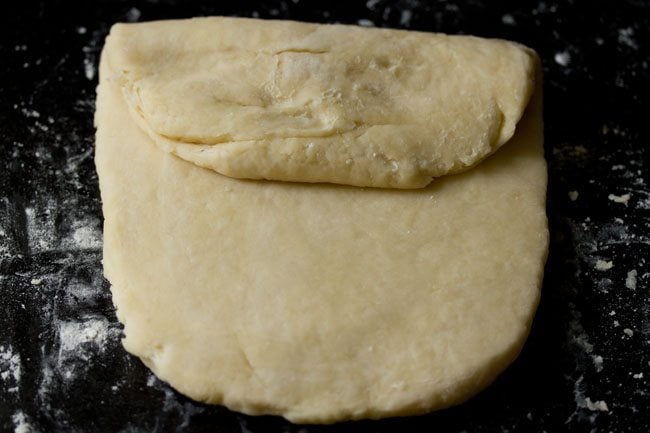
25. This is the fifth fold. Again roll and fold.
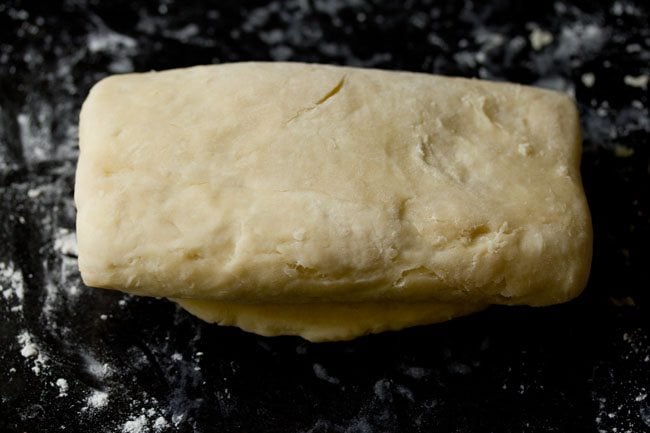
26. Once the last folding is done, then gently roll a bit to even the dough. You will see this last fold is much more smooth than the previous ones.
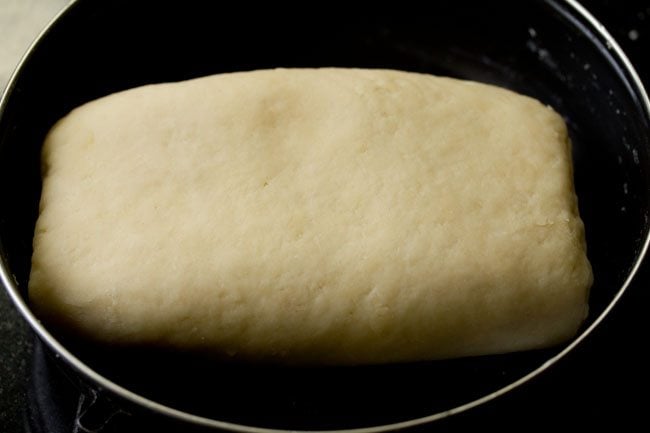
27. Cover with a foil or cling film and place in the fridge for an hour before you start shaping and making the pastries.
You can also keep overnight or for a day. If not using the dough in a day, then keep in the freezer. The dough should be completely covered, otherwise it will dry out in the fridge.
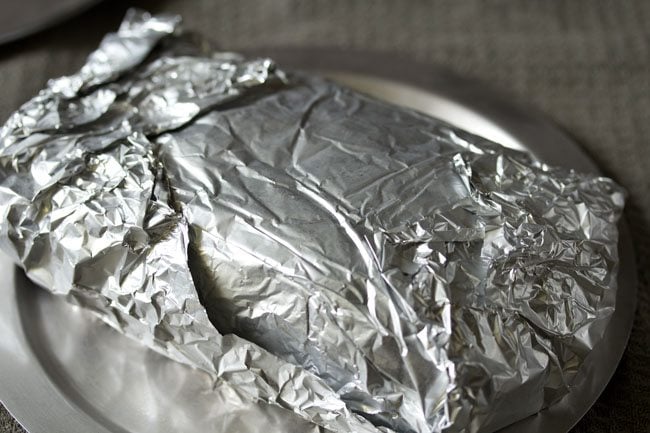
Using Homemade Puff Pastry Dough
- If refrigerated – then remove the pastry and keep at room temperature for 5 to 10 minutes.
- If frozen – then remove and keep at room temperature for 20 to 30 minutes.
- If not stuffing or filling the pastry with anything, then you can directly shape and bake without thawing/defrosting if frozen or if you have refrigerated the dough.
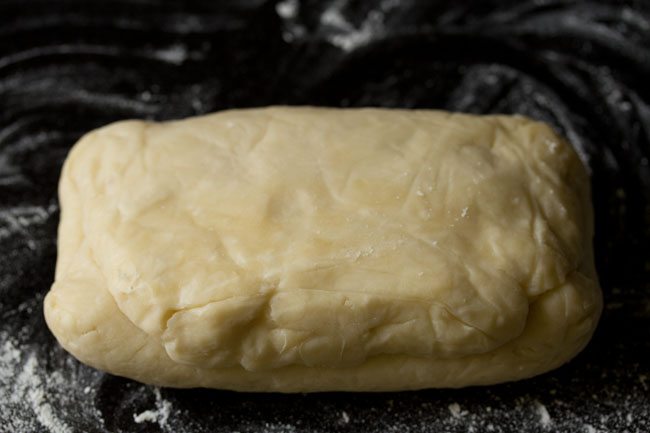
27. Sprinkle flour and then very lightly and just a bit, roll the dough. Just to make the surface even. Then slice the dough in two or three equal parts.
This depends on the quantity of puff pastries you want to make. Then roll and make puff pastries with your choice of fillings.
Do note that the filling has to be ready, before you roll and then stuff it in the puff pastry sheets.
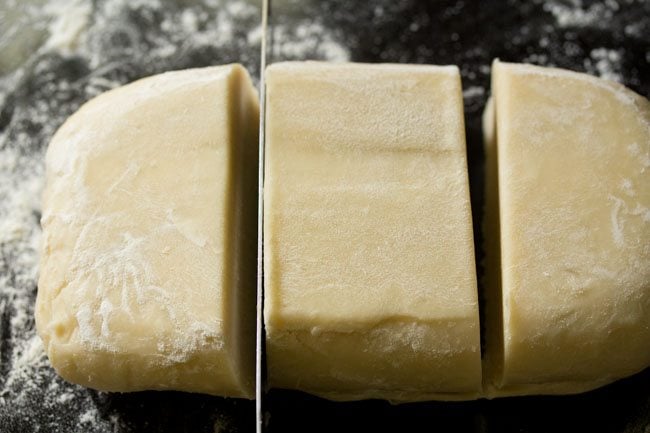
This recipe gives you about 900 grams (about 2 lb) of puff pastry dough. You can use the puff pastry the way you prefer to make various baked snacks.
It will suffice to make for 16 to 18 medium-sized turnovers or vegetable puffs.
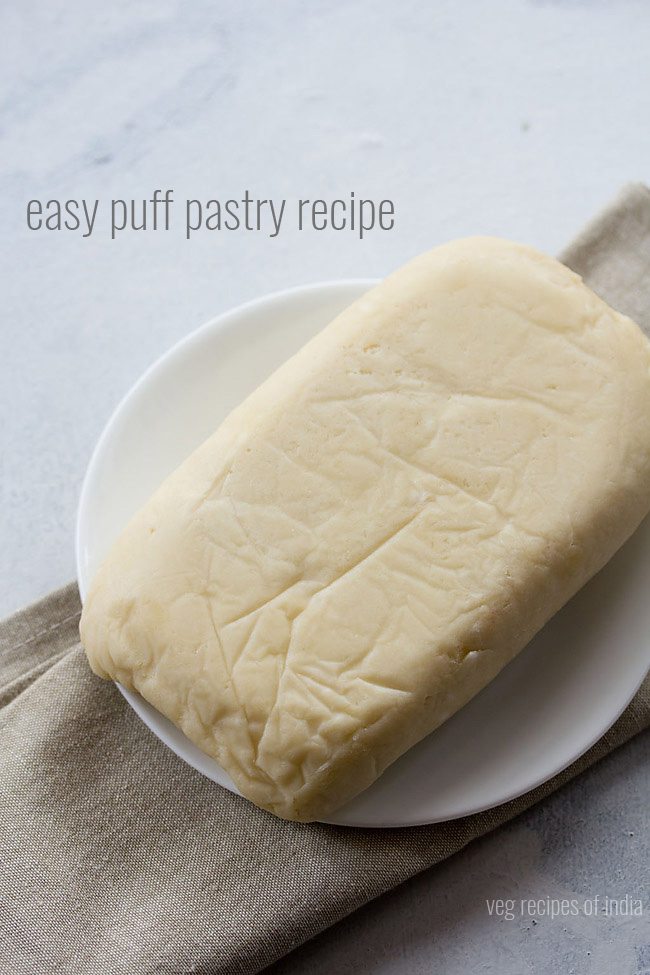
Use puff pastry dough to make your favorite recipes like:
- Sweet or savory tarts
- Turnovers
- Pot pies
- As a pie crust
- To wrap and bake brie
- To make hors d’oeuvres
- And so much more!
Expert Tips
Making rough puff pastry is simple enough, but there are a few things to keep in mind.
- Make sure to keep an eye on your local weather. Avoid trying to prepare this recipe during the hot and humid Indian summers. Puff pastries can end up in disaster if they aren’t handled well! Make sure your kitchen and work surfaces are nice and cool to keep your butter from melting and turning your pastry into a dense dough.
- If the butter begins to melt, refrigerate the dough for 20 minutes between each fold. Cover with a clean dish towel or plastic wrap before refrigeration.
- If possible, use a marble or stone surface for rolling the dough. It will maintain a lower base temperature than other materials.
- Cover the completed rough puff with foil or cling film and place in the fridge to rest for a minimum of an hour and up to 24 hours before you start shaping and making the pastries. If you are not planning on using the dough within a day of making it, then keep it in the freezer.
FAQs
What is the difference between puff pastry and rough puff pastry?
In the traditional method for making puff pastry, butter is incorporated into the dough in large slabs that are then rolled and folded many times over.
The process is quite lengthy and difficult, which anyone who has ever seen The Great British Baking Show can attest!
Rough puff pastry is a shortcut method to achieving deliciously laminated layers of dough by cubing the butter and using just a few folds. Rather than taking 2 to 3 hours, this recipe cuts the prep time to a mere hour.
Can I use a food processor to make rough puff pastry?
I don’t suggest it. We want large enough pieces of butter that will allow for pockets of steam when baking, which is what creates those lovely, flaky layers! Using a food processor makes the butter bits too small, resulting in a loss of lamination.
Is rough puff pastry sweet?
While it can certainly be used in sweet applications, no, this dough isn’t sweet at all.
How thin do I need to roll out the completed rough puff pastry to use it?
I’d suggest between ¼ to ½ inch thickness for most applications.
Step by Step Photo Guide Above
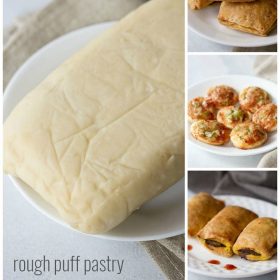
Rough Puff Pastry (Easy Foolproof Recipe)
Ingredients
- 375 grams all-purpose flour or 3 cups all purpose flour
- 250 grams Butter – unsalted or 2 cups chopped butter
- 1 teaspoon salt or add as required
- ¼ cup ice cold water + 1 tablespoon or add as required
Instructions
Mixing and preparing pastry dough
- Take the all-purpose flour and salt. If you want you can sift flour and salt together.
- Then mix very well. Set aside.
- Take the cold unsalted butter and chop it in 1 inch cubes. Overall you will need 2 cups of chopped cold butter. Do note the butter has to be cold and hard. It should not be soft.
- Now add the cold butter cubes to the flour and salt mixture.
- With a knife or pastry cutter roughly cut the butter in the flour.
- Some large pieces or cubes of butter should be there. Do not make to a breadcrumb consistency. The butter should not melt. If the butter begins to melt, then cover and place in the refrigerator for 30 mins.
- Then sprinkle ¼ cup + 1 tablespoon ice cold water all over. The water also has to be cold. So do chill water in the fridge before preparing the pastry.
- Mix with your hands and gently bring the dough together. Add 1 or 2 tablespoons more water if required to bind the dough or if the mixture looks very dry. Do not knead. You just need to collect and gather the dough. There will be some pieces of butter in the flour and its alright.
- When you get a rough piece of dough together, then cover and place in the same bowl or another bowl. Refrigerate for 45 minutes to an hour.
- After 45 minutes, sprinkle some flour on your work surface.
Folding and rolling puff pastry dough
- Remove the rough dough from the fridge and place it on the sprinkled work surface.
- Sprinkle some flour on the dough also.
- Now gently roll the dough in one stroke downward. If any piece of dough comes out, then stick it back to the dough.
- Make a 20 inches by 8 inches rectangle. Shape the sides to get a rectangle with the rolling pin.
- Now make two folds. First fold from the top and bring the fold till center.
- Overlap the second fold on top of the first fold.
- Now lift the folded dough and place the overlapped folded side facing your left hand side. The dough will be facing lengthwise to you.
- Again sprinkle some flour and gently roll in one stroke to make a rectangle.
- Again fold in the same way and keep the folded side facing your left hand side and gently roll.
- Repeat this folding and rolling 6 times.
- After the last rolling is over, then fold again in the same way. Then gently roll a bit to even the dough. You will see this last fold is much more smooth than the previous ones.
- Do note that if the butter begins to melt, then refrigerate the dough for 20 minutes after every fold. Cover the dough and keep in the fridge. In hot and warm temperatures you may need to do this.
Storage and Uses
- Cover with a foil or cling film and place in the fridge for an hour before you start shaping and making the pastries. You can also keep overnight or for a day. If not using the dough in a day, then keep in the freezer.
- This recipe make for about 900 grams (about 2 lb) of puff pastry dough. It will suffice to make for 16 to 18 medium-sized turnovers or vegetable puffs.
- Use puff pastry dough to make your favorite recipes with it like sweet or savory tarts, pies, turnovers, pot pies etc.
- If you have refrigerated the pastry dough, then remove the pastry and keep at room temperature for 5 to 10 minutes before using it for any recipe.
- If the dough is frozen, then remove and keep at room temperature for 20 to 30 minutes before using it.
- If not stuffing or filling the pastry with anything, then you can directly shape and bake without thawing/defrosting if frozen or if you have refrigerated the dough.
- While making recipe that has a stuffing or filling, sprinkle flour and then very lightly and just a bit, roll the dough. Do note that the filling has to be ready, before you roll and then stuff it in the puff pastry sheets.
- This is just to make the surface even. Then slice the dough in two or three equal parts.
- This also depends on the quantity you want to make. Then roll and make puff pastries with your choice of stuffings or fillings.
Notes
- Make sure that the butter and water are cold. The butter should be not be soft or melted.
- For the flour, preferably use organic all-purpose flour or unbleached all-purpose flour.
- Avoid trying to prepare this recipe in hot and humid seasons. Puff pastries can end up in disaster if they aren’t handled well. Make sure your kitchen and work surfaces are nice and cool to keep your butter from melting and turning your pastry into a dense dough.
- If the butter begins to melt, refrigerate the dough for 20 minutes between each fold. Cover with a clean dish towel or plastic wrap before refrigeration.
- If possible, use a marble or stone surface for rolling the dough. It will maintain a lower base temperature than other materials.
- The approximate nutrition info is for the entire puff pastry dough made from this recipe.
Nutrition
This Rough Puff Pastry recipe from the archives, originally published in August 2016 has been updated and republished on February 2023.

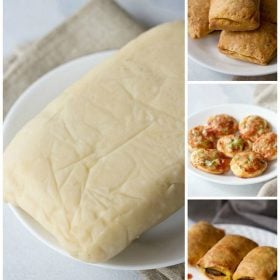
Hello! Will this recipe work if we substitute ghee with the butter listed?
Butter is best to use. Ghee might bring in too many of its flavors and aroma in the puff pastry and I would not suggest it.
Which butter is advised to use? Real amul butter or other cheap margarine or amul delicious or same type of what is called like vimal etc.?
Real butter made with milk cream and not any substitute butter or margarine or flavored butter. Use any good brand but do check for the ingredients on the package.
Hi i am using microwave convection oven. It has microwave,grill,convection, combination as its mode. Which mode am i supposed to used for making puffs.
Gvv, only use the convection mode. don’t use combination mode or microwave mode or grill mode.
Hi Dassana,
The butter started melting while rolling and I had to literally keep it in the fridge after each roll. So ended up doing traditional way ?One doubt I have is in this case whether traditional method is better because we are keeping 1 rectangular butter piece in the middle and rolling. So will it help in reducing melting? The method used here has large amounts of butter cubes in the dough. Also I have seen some videos where melted butter is used and a tsp of it is spread after each roll.
remya, in warmer or hotter days, the butter does melt. in traditional method also butter melts. while living in goa, where it is more hot, the butter would melt always. i tried three to four times with the traditional method and then gave up. even i have seen some recipes where melted butter is used. but i do not know how the texture will be. you can chop the butter cubes to slightly smaller cubes and then add to the flour.
Thanks for the reply. Will try and let you know ?
welcome remya. sure do let me know.
heyy
i made this ,first time did not puffed as i made it so thin the dough,
but next time i made it thick as 1cm and kept it cold to oven and yesss it turned out so good and the layered opened up.
tnxxxx to u a bunch
yes mahsa, the pastry sheet has to thick when adding the filling, otherwise they do not puff. the sheets have to be cold when stuffing is added as that helps them to puff well when baking. good to know that second time the results were good and you did the right thing.
awsome as always!
i guess you need to correct the preparing time
thanks mahsa. will update the preparing time.
How many days can it b kept on freezer…..van the recipe b halved?
yes recipe can be halved. keeps good for 1 to 2 months.
A big big big thank you… I never thought I can make this at home… loved it very much
its our pleasure shona, thanks for positive views.
Okay i will use pure ghee ok let me try n ger bck to yu
sure harshya.
Can i use frizzed ghee instead of butter
you can use ghee. but with ghee the aroma changes. though i think it will still taste good. but don’t use dalda or vanaspati as they are hydrogenated fats and not good for the heart.
can i use whole wheat flour instead of all purpose flour??
i tried twice with whole wheat flour and crust did not come out good when baked. its dense and moreover there is no lightness. so i would suggest to use all purpose flour. but you can give a try with half-half of both whole wheat flour and all purpose flour. if using whole wheat flour, then some more water will be required to bind the dough.
Can i use any branded salted butter? Its difficult to get unsalted butter
you can use any brand of salted butter.
Hi, just saw your app recommendation on Sunday Times Life. Kudos for all your efforts.☺
thanks bhawna 🙂 for your kind words.
hi, shouldn’t there be more butter added to the pastry during the process of rolling? puff pastry is about putting butter between the pastry, so that it can divide and become puffy during baking.
ania, the method that are you are mentioning, is the traditional method. this is a quick rapid method of making puff pastry and helps homemakers who do not have much time on hand, but want to make puff pastry dough at home for their kids and family. these also get puffed up while baking but not that much as compared to the ones which are conventionally made. i will add the traditional method too in some time.